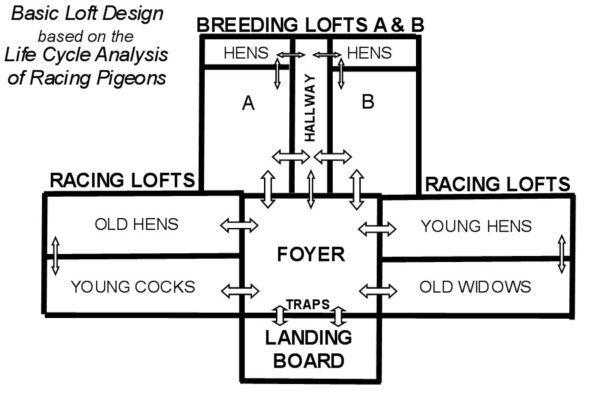Pigeon Feeding – Feeding to Win
 During the racing season, the main function of food is to provide the fuel for flying. Our common aim is to provide the racing pigeon with the best fuel for race day. To do this consistently we must have a good understanding of the food itself. The following paragraphs will introduce you to the science (or theory) of feeding, but for racing success you must also become expert at the practice (or art) of feeding. Only practice and observation can teach you the art of feeding, but hopefully the methods of feeding described here can help you find the pathway to feeding success.
During the racing season, the main function of food is to provide the fuel for flying. Our common aim is to provide the racing pigeon with the best fuel for race day. To do this consistently we must have a good understanding of the food itself. The following paragraphs will introduce you to the science (or theory) of feeding, but for racing success you must also become expert at the practice (or art) of feeding. Only practice and observation can teach you the art of feeding, but hopefully the methods of feeding described here can help you find the pathway to feeding success.
We can only begin the art of good feeding when both the quality of the food is guaranteed and the flock is healthy. A healthy bowel is required before we can test our feeding systems, because an unhealthy bowel fails to deliver the fuel of good grain to the pigeon’s body. Bowel diseases such as E. coli, coccidiosis, worms and wet canker all decrease the amount of nutrients entering the body.
By using the best quality grains and with a healthy race team, the fancier can now think about a racing mix appropriate for his particular family of birds and training methods. The mix chosen must provide a good balance of protein (amino acids) and for this to be achieved at least 8 different grains must be used. After this balance is achieved, the energy content of the mix becomes the most important part of successful feeding.
The feed system provides the race team with the correct energy levels for training and racing. The goal of feeding is to provide the training and racing pigeon with exactly enough (not too much and not too little) fuel (energy in the food) for sustained flight (loft exercise or racing). Of course, the fuel requirements of the training pigeon vary enormously from day to day. It is the constantly changing energy requirements of the competition pigeon that makes feeding such a challenge to even the best fanciers. The competition pigeon will not perform to its fitness level when the “energy balance” is incorrect. The “energy balance” must be assessed short term (daily) and long term (weekly) with fit flocks during the race season, because the fitness level will drop both when too much and too little energy is supplied. During young bird training special attention must be made to prevent depletion of the energy reserves in the liver and muscle.
Overfeeding relative to workload (positive energy balance) renders the race team less competitive because of excess baggage (“leady”). Excess energy is stored as fat with subsequent loss of buoyancy and fitness. It is well to remember that the excess energy of mixes which are too high in protein (legumes) relative to the work load will be stored as fat.
Underfeeding relative to workload (negative energy balance) renders the race team less competitive because of “depowering”. Feed systems low in energy relative to the workload of the race team will result in the depletion of the energy reserves in the liver, fat and muscle.
The fancier can recognise a race team that is in a negative energy balance by the following signs:
- No wing flapping in the early morning or after feeding.
- Disinterest in leaving loft or toss basket, lower lid laziness etc.
- The race team in negative energy balance (inadequate energy intake relative to the workload) is susceptible to illness, especially “respiratory” diseases.
Buoyancy
Most fanciers understand the importance of buoyancy for success, but few understand the best way to achieve this in their race teams. Buoyancy is best achieved by supplying the flock with enough feed (a positive energy balance) to promote vigorous loft flying (or tossing) in order to maximise lean body mass (i.e. muscle) and minimise body fat. Instead many fanciers believe that the best path to buoyancy is to restrict caloric (energy) intake (feed less) in order to lose excess weight and thereby produce the buoyancy that we see with top form. However, buoyancy is not only weightlessness, but also power, and the buoyancy of fitness only comes when lean body mass is maximised. The restriction of calories in an effort to produce buoyancy in fact lowers the fitness level of the flock and renders it susceptible to illness. Severe caloric restriction will cause a loss of not only body fat but also lean body mass (muscle) with the accompanying loss of fitness and power.
I’m sure you can see by now why feeding and nutrition is so importnat to your birds, if you would like to get access to our own personal feeding and nutrition program which will show you in-depth how to seperate yourself from your competitors with proper feeding and nutrition and give your birds a head start in their next race then => click here.
Pigeon Feeding – Feeding to Win by Dr. Rob Marshall
Like this article? then you’ll love Pigeon Racing Nutrition Secrets Exposed










hi my name is albert i am new the sport but not sure how much to feed my birds
well I am in the new sport too and I definitely am not sure how to take care of pigeons cuz I have not gotten my pigeons yet, so keep up the good work.
Thanks for the great info on feeding Chris! keep-up the good work!
do anybody no how to feed young birds just got them in 4 days ago seem like their going light very young racing homers and a feed program for racing bend racing for 3 yrs no one tell me anything i want to kick there butt pay back please help
Hi pj i think you better have them checked out if the four of them are going light there is
something wrong.As far feeding goes i use barley sunday to tuesday and and good feed
mix with very little peas wed day and thursday oil seeds black sunflower flax etc i do
not feed my young birds much the day of shipping small seed first thing in the morning.
Brad.
when you say feed barley is that all you feed them on those days, and what about returning from race sat
In the beginning of this years racing season everything went well. Winning a sprint race but as it got longer the races got tougher,with many losses. Was by no means in the reconing. What went wrong because the feeding stayed the same,training stayed the same, everything? Usually i increase the feed from the time we reach the 550 km mark. What can be done????
Morne with the stress of racing ect ur birds probably become unwell, u probably should treat for respiratory disease.
Birds should feel silky to touch, the droppings should NOT be wet and should have down feathers on them in the morning also as the racing gets longer u need to increase the fat content of the food.
When I first started with homers was 2003 I made sure birds had enough reserve to get back home birds that I lost could have hit a wire or been grab by hawk 12 races only lost 3 birds started out with 30 I had birds at top middle and bottom of the sheet It wasn’t to just resent that I realized by reading pigeon Insider what I was doing wrong every bird at my loft goes out I have my 03 team loft flying and routing just as long as my 2010 young birds most of my birds are in great shape but not all are some are going Thur molt while others are passed it a few sick ones showed up so i will say it again DON’T OVER CROWD YOUR PIGEON…
You might be able to handle things for awhile but seasons change and you have to know how to change with them. It’s real easy to stress a pigeon and not even know it until they start dropping on you.
ROYALSLOFT
ANDY RIVERA
New Zealand land of the Maple pea good quality seed. Barley a must for breeding and racing. Long grain brown rice high in carbs along with Sorghum (milo)
Safflower very high in protein and great as a trapping seed
New Zealand land of the Maple pea good quality seed. Barley a must for breeding and racing. Long grain brown rice high in carbs along with Sorghum (milo)
Safflower very high in protien and great as a trapping seed
hi i m from india can anyone send pigeons to india bcoz i like to have pure breed
Thank you
I mix my own feed there is a web site birdhealth.com.au that has some good formuals I have mixed the stanard and then add more peas and barley to feed my breeders and the young look and feel great and race team is flying good to.
i am new 2 the sport i have have my race team on garvo
iv got my pigeons on garvo i am new 2 the sport is it en good